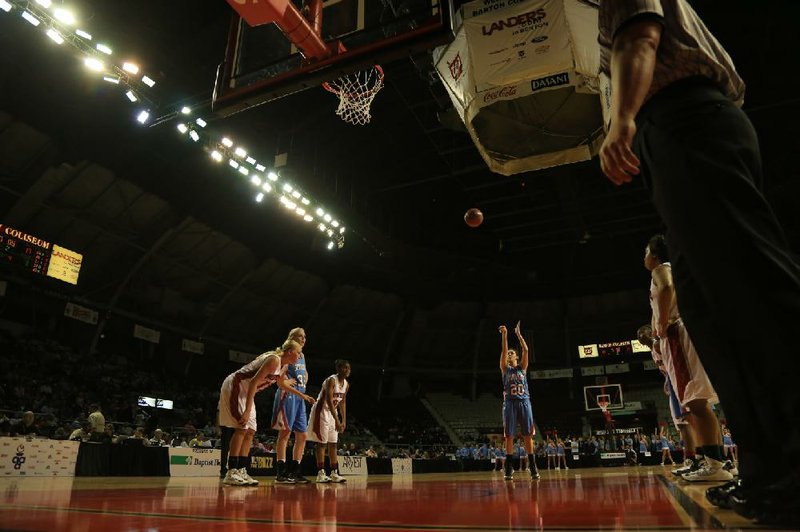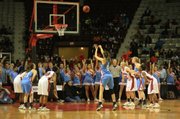Joe Kleine was talking about basketball. Of course he was. He’s an assistant coach for the University of Arkansas at Little Rock men’s team and a former NBA player.
The specific topic was how to be a better shooter of free throws.
And then, Bubba Watson jumped into the conversation.
Right. The golfer. The guy who made that great shot last year to win the Masters Tournament.
People will talk about that shot as long as azaleas bloom at Augusta National, as long as duffers hack balls into ponds, as long as …
Right. Great shot. But what does that have to do with shooting free throws? Only everything.
Let’s examine Watson’s shot.
Final day of the tournament.
Watson’s on the second playoff hole, tied with Louis Oosthuizen.
The pressure is enormous.
Watson tees off, and hooks the ball so deep into the trees right of the fairway he can’t see the green.
Lucky for him, Oosthuizen bangs his tee shot off a tree. He’s a long way away, too, but at least he can see the green.
Watson pulls out a wedge. The sea of spectators parts, Watson is like Moses at the Red Sea, if Moses were wearing a golf cap.
Hundreds of people are right there, watching, as Watson hooks his second shot - but this time on purpose - up and over the trees and onto the green, 155 yards away. The balls lands about 10 feet from a hole he never saw.
Two putts, a par, and Watson wins.
Sitting in his office on campus, Kleine shook his head at the thought. Watson had it all - concentration, confidence, skill, all the result of practice, practice and better practice.
Just like free-throw shooting.
Concentration. Confidence. Skill.
All the result of practice, practice and better practice.
Bobby Vint is 66 years old and has a lifetime of basketball behind him as a player, coach and broadcaster. Bobby Vint knows basketball - and how it has changed over the decades. Or hasn’t.
Today’s players are bigger, stronger, faster. They fly down the court and soar above the rim. The free throw in comparison is so … prosaic. So … archaic. So … vital.
“Just as important as ever,” Vint said. “Look at the example from last night.”
By which he meant the Jan.
16 game between Arkansas and Auburn. Arkansas won, 88-80, in double overtime. But it didn’t have to be that way, as explained by Tom Murphy of this newspaper.
“Auburn made 7 of 17 free throw attempts (41.2 percent) … Arkansas was 20 of 33 (60.6 percent), but Mardracus Wade missed both ends of a two-shot opportunity with the Hogs ahead 67-64 with 25.9 seconds remaining. Wade also missed the back end of a two-shot foul after tying the game 75-75 with 35 seconds left in the first overtime. The Hogs went just 6 of 10 from the free-throw line in the second overtime.”
Wade had a chance to ice the game in regulation at the previously mentioned 25.9 mark.
Had he hit one or the other, the three-pointer by Auburn that tied it up with five seconds left would have been moot. That shot, by Allen Payne, was a prayer, answered in the affirmative by the basketball gods.
To be fair, the basketball gods could have pointed out that had either team shot decently from the free-throw line - 10 misses for Auburn; 13 misses for Arkansas - there would have been no need for overtime.
Free-throw shooting is more than points on the board, Vint said.
“In today’s game there’s so much slashing to the goal. Players are such good ball handlers. If they don’t make the shot, there’s a good chance they’ll be fouled.
That puts an individual and the other team in foul trouble. After 10 team fouls, you get the double bonus - two shots.”
That’s where Mardracus Wade was when he clanged those two free throws with 25.9 left in regulation - in the double bonus, an advantage wasted.
In Wade’s defense, Vint said, it’s not as easy as it looks.
“For the lay person,” he said, “there’s no guarding, it’s the same distance, the same ball, the same place. You’ve got a good chance to be successful. What changes that is the pressure. You should be comfortable, but it’s hard to explain the pressure unless you’ve been there.”
Attendance at the Auburn game in Walton Arena was 10,056. That’s 20,112 eyeballs bearing down on poor Mardracus Wade. How many eyeballs watch us Ordinary Joes at work? Not 20,000, that’s for sure.
Vint advocates developing a routine at practice “to alleviate the pressure, to put the game situation out of your mind and concentrate on the routine you’ve practiced hundreds and hundreds of times.” The quality of the practice, Vint said, is more important than the number of free throws shot. Coaches should create a consequence for a miss, like line drills. Or create a competition betweenteam members in practice.
Way back when, growing up in North Little Rock, Vint learned from his coaches, Henry Hawk and Bob Bowden, the fundamentals of shooting, and how to use free throw practice to improve overall shooting technique. Those fundamentals aren’t exactly rocket science, he said.
Have good finger distribution on the ball. Spread those fingers.
Keep the shooting elbow under the ball.
The off hand is used only to guide the ball up to the point of release.
Shooting starts at the feet. Develop a rhythm at the feet.
There, wasn’t that easy? Please add discipline and repetition. Develop a routine, because a routine gives a shooter a moment to relax under game pressure.
Don’t forget to bring along some confidence.
“You’ve got to have something in your craw.”
The maestro of the free throw in Arkansas is Tommy Boyer, who played varsity basketball at the University of Arkansas for three seasons in the early 1960s.
To achieve maestro status, Boyer once (but no longer) held three NCAA free-throw shooting records: Single season, 93.3 percent made; career, 89.2 percent; consecutive, 44.
Forty-four? Yes, helped out by Texas Tech, which sent him to the line for 18 made in a row.
Decades later, Boyer still wonders why Tech fouled him so much.
“What kind of village idiot would put you on the line 18 times when you’re a 90 percent free-throw shooter?” he asked. Not necessarily rhetorically.
Good free-throw shooters, he said, “will do anything to get to the free throw line. That’s where they’re most comfortable … you put him on the free throw line, you’re playing his game if he’s up in the 80 to 90 percentile.”
Boyer so believes in the power of the (made) free throw that he spoke at length about it in a 2008 commencement address to graduates of the Walton College of Business at the University of Arkansas.
Being good at free throws involves some key characteristics that also apply to professional life, Boyer told the graduates.
A strong work ethic. “[Y] ou have to put in the time and you have to be willing to practice day in and day out to get better.”
Concentration. Block out the noise. Focus on the task at hand.
Repetition. Learn how to do things the right way, “and then repeat them over and over to refine and perfect your technique.”
Develop a short memory for failure. Don’t dwell on the missed shot. Look ahead to the next shot.
Visualize the shot going in. “It’s important to rehearse being successful in your mind.”
Commitment. Be committed to learning and improving.
Relax and enjoy, because “you will have to deal with pressure and adversity; if you hate the pressure, you are probably in the wrong job.”
Boyer must have been in the right job, having worked for many years for Eastman Kodak and then starting his own business. In February he was inducted into the Arkansas Business Hall of Fame. That means he has made both ends of a one-and-one - he’s already in Arkansas Sports Hall of Fame.
A little confidence helps.
“You are what you think you are,” Boyer said, “and will become what you think you will become, which means success will follow your thoughts.”
Joe Kleine was - still is - a basketball big man, 6 feet, 11 inches tall. A lot of big men don’t shoot free throws so well. Wilt Chamberlain shot at a 51.1 percent clip in the pros. Shaquille O’Neal was only marginally better at 52.7 percent. Bill Russell, Chamberlain’s arch-rival, shot free throws at a rate of 56.1 percent. Kleine’s career NBA average was 79.4 percent.
Big men play around the rim, Kleine said, and shoot from within five feet of the basket, and often don’t learn to shoot from a distance. Smaller players have to learn to shoot from away and tend to develop arc and rotation.
Think of shooting a basketball as being like hitting a golf shot, he said.
“You get a 9-iron shot up into the air with spin, and it will stay on the green. Spin and arc make for a softer shot. The softer the ball hits the rim, the better the chances it will go in.”
UALR expends plenty of effort on free throws, Kleine said.
Players are required to shoot 250 free throws a week in the off-season and report their percentages. During the season, there’s not a day without free-throw practice. Pressure is added to practice. Make 18 of 24 shots or run the length of the court twice. “We try to put a little pressure on them,” Kleine said, “make a consequence.”
Developing a routine is the most important thing. A couple of dribbles, spin the ball, shoot.
“We try to talk about trust your shot, trust your shot. So when you go to the line with no time left, you think about your shot and not the situation.”
Toss in confidence.
“You can’t go to the line questioning yourself.”
ActiveStyle, Pages 25 on 03/25/2013


